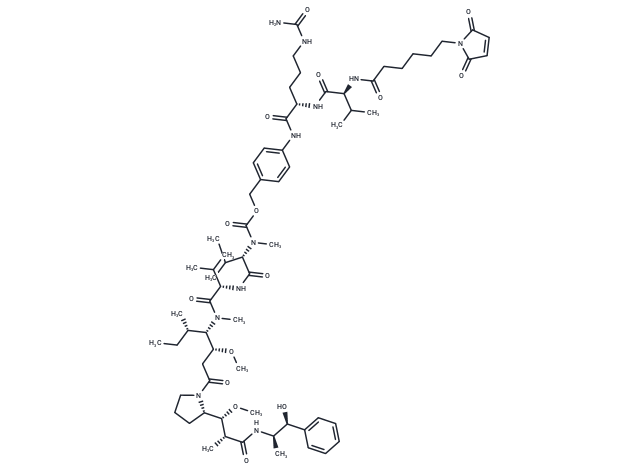Shopping Cart
- Remove All
 Your shopping cart is currently empty
Your shopping cart is currently empty

VCMMAE (mc-vc-PAB-MMAE) is a drug-linker conjugate for ADC with potent antitumor activity.

| Pack Size | Price | Availability | Quantity |
|---|---|---|---|
| 2 mg | $30 | In Stock | |
| 5 mg | $48 | In Stock | |
| 10 mg | $89 | In Stock | |
| 25 mg | $163 | In Stock | |
| 50 mg | $263 | In Stock | |
| 100 mg | $397 | In Stock |
| Description | VCMMAE (mc-vc-PAB-MMAE) is a drug-linker conjugate for ADC with potent antitumor activity. |
| In vitro | MMAE sensitized colorectal and pancreatic cancer cells to IR in a schedule and dose dependent manner correlating with mitotic arrest. Monomethyl auristatin E (MMAE) is efficiently released from SGN-35 within CD30+ cancer cells and, owing to its membrane permeability, it has the ability to exert cytotoxic activity on bystander cells. Radiosensitization is evidenced by decreased clonogenic survival and increased DNA double strand breaks in irradiated cells. |
| In vivo | Monomethyl auristatin E (MMAE), when combined with IR, enhances DNA damage signaling and CHK1 activation, delaying tumor growth. Tumor-targeted ACPP-cRGD-MMAE with IR induces more robust and significantly prolonged tumor regression in xenograft models. |
| Cell Research | Monomethyl auristatin E is reconstituted in DMSO at a concentration of 5 nM. Monomethyl auristatin E (MMAE, 5 nM) and ionizing radiation (IR) treated cells are harvested and lysed in RIPA buffer with protease and phosphatase inhibitors. 30 μg of lysate undergo electrophoresis using 4-12% Bis-Tris gels, transferred to PVDF membranes and incubated with indicated primary antibodies. |
| Animal Research | 6-8 week old female athymic nu/nu mice are injected subcutaneously into thighs with 5×106 HCT-116 or PANC-1 cells in a 1:1 Matrigel and PBS solution. Mice are treated with IR or intravenous (IV) injection of ACPP-cRGD-MMAE (6 nmoles/day, 18 nmoles total, i.v.), tumor tissue is harvested, formalin fixed and paraffin embedded followed by staining with indicated antibodies. The primary antibody is used at a 1:250 dilution and is visualized using DAB as a chromagen with the UltraMap system. |
| Alias | mc-vc-PAB-MMAE |
| Molecular Weight | 1316.63 |
| Formula | C68H105N11O15 |
| Cas No. | 646502-53-6 |
| Smiles | CC[C@H](C)[C@@H]([C@@H](CC(=O)N1CCC[C@H]1[C@H](OC)[C@@H](C)C(=O)N[C@H](C)[C@@H](O)c1ccccc1)OC)N(C)C(=O)[C@@H](NC(=O)[C@H](C(C)C)N(C)C(=O)OCc1ccc(NC(=O)[C@H](CCCNC(N)=O)NC(=O)[C@@H](NC(=O)CCCCCN2C(=O)C=CC2=O)C(C)C)cc1)C(C)C |
| Relative Density. | 1.196 g/cm3 (Predicted) |
| Storage | store at low temperature,keep away from moisture | Powder: -20°C for 3 years | In solvent: -80°C for 1 year | Shipping with blue ice. | |||||||||||||||||||||||||
| Solubility Information | DMSO: 54 mg/mL (41.01 mM), Sonication is recommended. | |||||||||||||||||||||||||
Solution Preparation Table | ||||||||||||||||||||||||||
DMSO
| ||||||||||||||||||||||||||

Copyright © 2015-2025 TargetMol Chemicals Inc. All Rights Reserved.